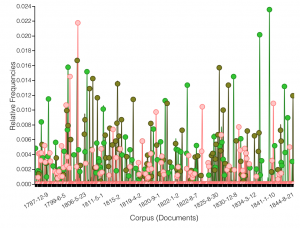The abundance of extant Edgeworth correspondence perfectly suits it for digital transcription, encoding, and searching. Unfortunately, the fact that Edgeworth’s letters are held in repositories and collections around the world has resulted in publications that represent and provide access to only a portion of her correspondence and reflect an unnecessarily limited view of her interests and commitments. A digital archive of Edgeworth’s letters will allow scholars to map her correspondence network, identify her extensive reading practice, nuance our understanding of her engagement with political and intellectual trends over time, track verbal patterns, and expand knowledge of her writing and revision processes throughout her prolific career.
For example, Valerie Packenham’s recent Maria Edgeworth’s Letters from Ireland, while including letters from 1798 to 1849, features a selection of only some complete letters supplemented by excerpts and editorial commentary. Christina Colvin’s 1971 Maria Edgeworth: Letters from England 1813-1844 and 1979 Maria Edgeworth in France and Switzerland reproduce only those letters held by the National Library of Ireland and those held, at the time, privately by friends and family. Augustus Hare published The Life and Letters of Maria Edgeworth in 1894, but his work was drawn almost entirely from the privately printed and circulated 1867 A Memoir of Maria Edgeworth by Frances Edgeworth, Maria’s step-mother, and Frances’s two daughters, Harriet Butler and Lucy Robinson. The idiosyncratic selection, error prone transcription, and subjective editing of the letters in these works has left us with a partial and distorted view of Edgeworth’s mind and circle.
Despite these limitations, basic digital textual analysis of the letters in Hare’s edition provides intriguing suggestions for the future work that a digitally encoded and searchable repository of Edgeworth’s letters would enable. Uploading the 397 complete and partial letters of Hare’s text into Voyant – an open-source, web-based text analysis application – produces two interesting visualizations. First, of the corpus’s 195,368 total words and 14,930 unique word forms, the word cloud or “cirrus” (figure 1) reveals that the word “thought” occurs 149 times, “read” occurs 161 times, and “know” occurs 199 times.

While it may not be particularly surprising that these letters reflect Edgeworth’s interest in reading, thinking, and knowing, in combination with the graphing of these terms over the years represented by her correspondence (figure 2), we can see how Edgeworth’s thought process and knowledge acquisition directly correlated with her reading. As she read (represented in dark green), she transformed thought into knowledge (represented in pink). Digital transcription, encoding, and searching of Maria Edgeworth’s letters, will enable much more interesting and valuable insights into what and whom exactly Edgeworth read, what knowledge she created, and with whom and for what purposes she shared it.